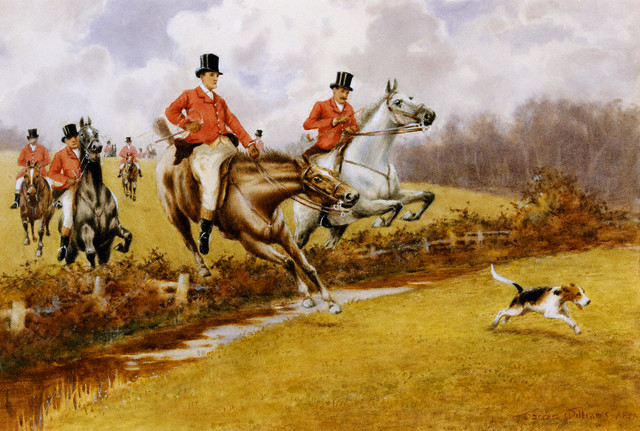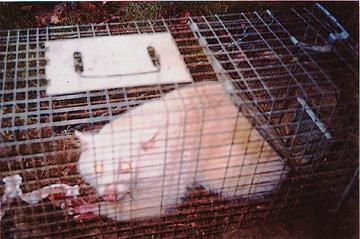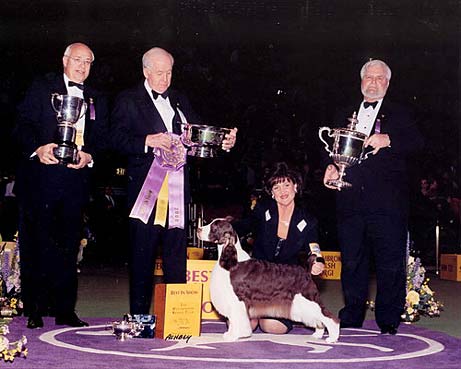Fufus & Fidos
March 20, 2000, National Review by Jonah Goldberg
New York City -- Suddenly, John was the favorite to win. “Johnny” could switch from taciturn to playful in an instant, but he was — above all things — a fierce competitor, a purebred warrior like his father and grandfather before him. Only months earlier, he’d been written off as a long shot whose few wins were undeserved, establishment-bucking flukes. Now all that stood between him and the brass ring was the “son”: the pedigreed scion of bluebloods dripping with the sense of entitlement that comes with the blessing of the establishment. The son had never suffered, never sacrificed. His victories came easily. Throughout 1999, the pundits had pegged him as the obvious favorite. Still, Johnny, the outsider, had an uncanny appeal. “There’s just something about Johnny that everybody loves. I can’t explain it,” said one experienced observer.
John McCain versus George W. Bush? A good guess. But while other journalists were eating Krispy Kremes on the Straight Talk Express, I was wading deep into the World Series of doggiedom, the 124th annual Westminster Kennel Club Dog Show held at Madison Square Garden. This is the second-oldest annual “sporting event” in America, only one year younger than the Kentucky Derby. This contest was supposed to be between “Johnny,” a.k.a. Hi-Tech Johnny J of Boxerton, and “Treson,” a.k.a. Lake Cove That’s My Boy. Hi-Tech Johnny is a boxer, and Treson is a standard poodle. More accurately, he is the poodle-the “winningest dog of all time of any breed,” according to Sports Illustrated.
One hopes the analogy to presidential politics will not hold, since both dogs were bested by a third contender in a stunning upset. The winner, the Al Gore of the race, was a springer spaniel appropriately named “Shameless” — which is especially ironic, because many of the dogs seem so embarrassed to be here in the first place.
As you walk through the backstage grooming area, you see maybe a hundred dogs standing on what appear to be small ironing boards. The longer-haired breeds — Pekinese, Shih Tzus, sheepdogs, etc. — are so covered in special dog hair-rollers that, at first glance, the beasts appear to be under attack by bright blue grasshoppers. One bearded collie being assaulted by a hairdryer has his bangs bundled into a rhino horn of fur; he looks up at me with an expression of intense humiliation. A caged German shepherd is in even worse straits: “Please,” his eyes plead, “kill me now.”
It’s not an easy life, and one would forgive the pups for mounting an insurrection. But the dogs are invariably better behaved than the humans at the show. The event is crowded, loud, and thoroughly disorienting. There is a great deal of commerce: Dog-food cookbooks, dog-motif jewelry (“The Fine Arf Collection”), and even canine self-help manuals (“When Pets Come Between Partners”) are hawked at stalls lining every wall. In the area where the dogs are put on display, thousands of people push, poke, shove, and shriek. In this tense, almost gladiatorial locker-room atmosphere, owners and groomers can get pretty testy.
But-among the canines, at least-there’s no biting, and no dogfights. Sure, there is the occasional excretory “accident,” but most dogs wait politely in long lines with their owners to use one of the sandboxes designated for that sort of business. In fact, to a dog-lover like me, it is precisely the un-canine nature of the event that is so disconcerting. Walking amidst these almost Prozac-calm descendants of wolves, one starts to worry; the dogs are almost too well behaved. Is that golden retriever with the ribbons in his hair suffering from what the Marxists would call “false consciousness”? Or is he just biding his time, waiting for the right moment to spark the mutiny? “Canines! Revolution! Throw off your leashes!” Perhaps not. But there is something odd about 2,600 dogs crammed into a room over two days, without a single recorded instance of a chewed shoe or nipped ankle. Indeed, this passivity reinforces the misgivings many dog-lovers have about the world of dog shows. Westminster rates dogs according to American Kennel Club guidelines, which judge appearance, not behavior; a champion dog is simply the one that best conforms to the picture in the guidebook. In other words, the “best” Labrador retriever at Westminster may not even know how to swim, let alone retrieve, but his ears will be the right distance from his nose. This is why, for example, Border-collie breeders fought tooth and nail against having their dogs recognized by the AKC. From the day they’re born, Border-collie puppies herd anything that moves — tennis balls, ducks, humans. Now, science has proven that a great deal of dog behavior is genetic. Pointers, for example, don’t necessarily need to be taught to point. (This fact of science is unappealing to liberal dog-lovers; when I made this point in another magazine, dozens of irate readers wrote in to accuse me of being an advocate of eugenics.)
Many Border-collie breeders feared, and fear, that breeding their dogs according to a standard derived solely from appearance instead of behavior could very easily result in dogs that look great but are useless for herding. Border collies remain the unparalleled champions in the burgeoning world of agility trials, contests that measure a dog’s intelligence and athletic ability; breeding for looks might attenuate the breed’s natural gifts.
But there is a second objection, which even many Westminster breeders will (secretly) endorse: The horrible dogs tend to win. “It’s always the dogs with the ribbons in their hair that win,” says the breeder of a big floppy hound. Indeed, since each dog is judged against the standard of its own breed-is the resemblance of Dachshund A to the Platonic ideal of Dachshunds greater than that of Rottweiler B to the über-Rottweiler?-the judging couldn’t be more subjective. “It’s all politics here,” a veteran dog journalist confirms. “The judges don’t like hounds.” Indeed, a cursory study of the statistics shows that doggy dogs-the kind of dogs that catch Frisbees, drink out of toilets, or appear in dogs-playing-poker paintings-do not fare well at Westminster. The judges prefer small, malleable, and exotically groomable dogs — the ones that are not only small enough to be carried in a purse, but also behave as if they belonged there. Last year, for example, the runaway winner was a papillon, a homely, twin-ponytailed dog with a face that looks as if it had been pushed in by a pastry chef’s thumb. The dog weighs less than an overripe honeydew and has fewer uses.
One does not want to traffic in stereotypes, but it remains a fact that as one walks from what amounts to the big-dog section to the small-dog section, the number of men practicing alternative lifestyles seems to rise dramatically. Indeed, one gets the sense that for men and women alike, many of these dogs take the place not so much of children, but of Barbie dolls. Treson, to take a notorious example, is a classic dog-as-dress-up-toy. This legendary “winningest” poodle is shaved down to his death gray skin on legs, rump, and snout. What fur he has is largely in snowball-shaped puffs that look almost glued-on, except above his eyes, where there is a shelf of white hair crowned with a huge white Afro.
“Westminster is pretty much a competition among hairdressers,” snorts a disapproving veteran. The assumption permeating Westminster is that these are the best dogs in the world, which prompts the obvious question, “Best for what?” Breeding dogs for their appearance is a relatively recent phenomenon. The original Westminster Dog Shows were contests for gentlemen and their hunting dogs; winning owners received pearl-handled revolvers. It looks as if dog-show culture is on a track parallel to that of the culture as a whole, demonstrating yet again the pertinence of the maxim, “It shouldn’t happen to a dog.”


